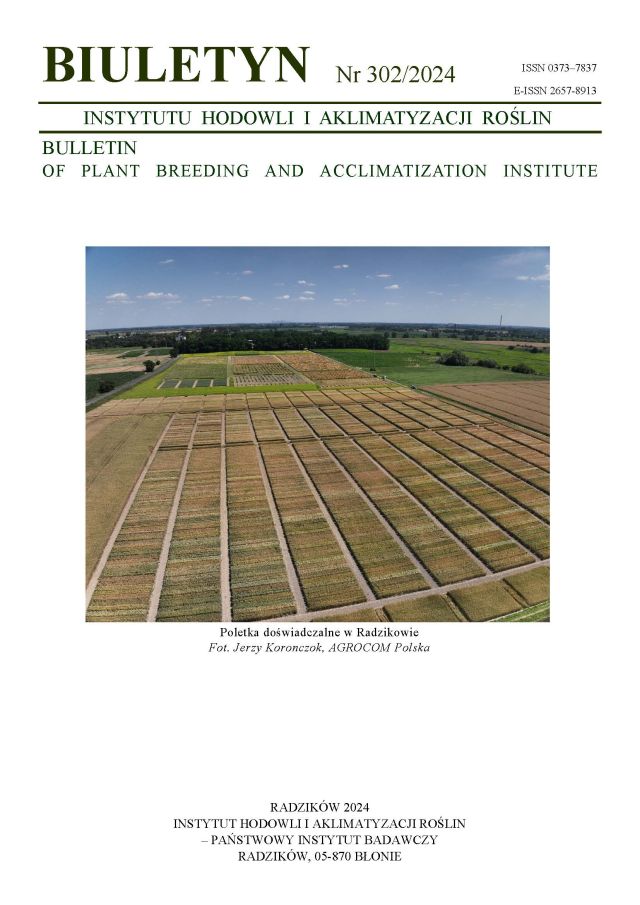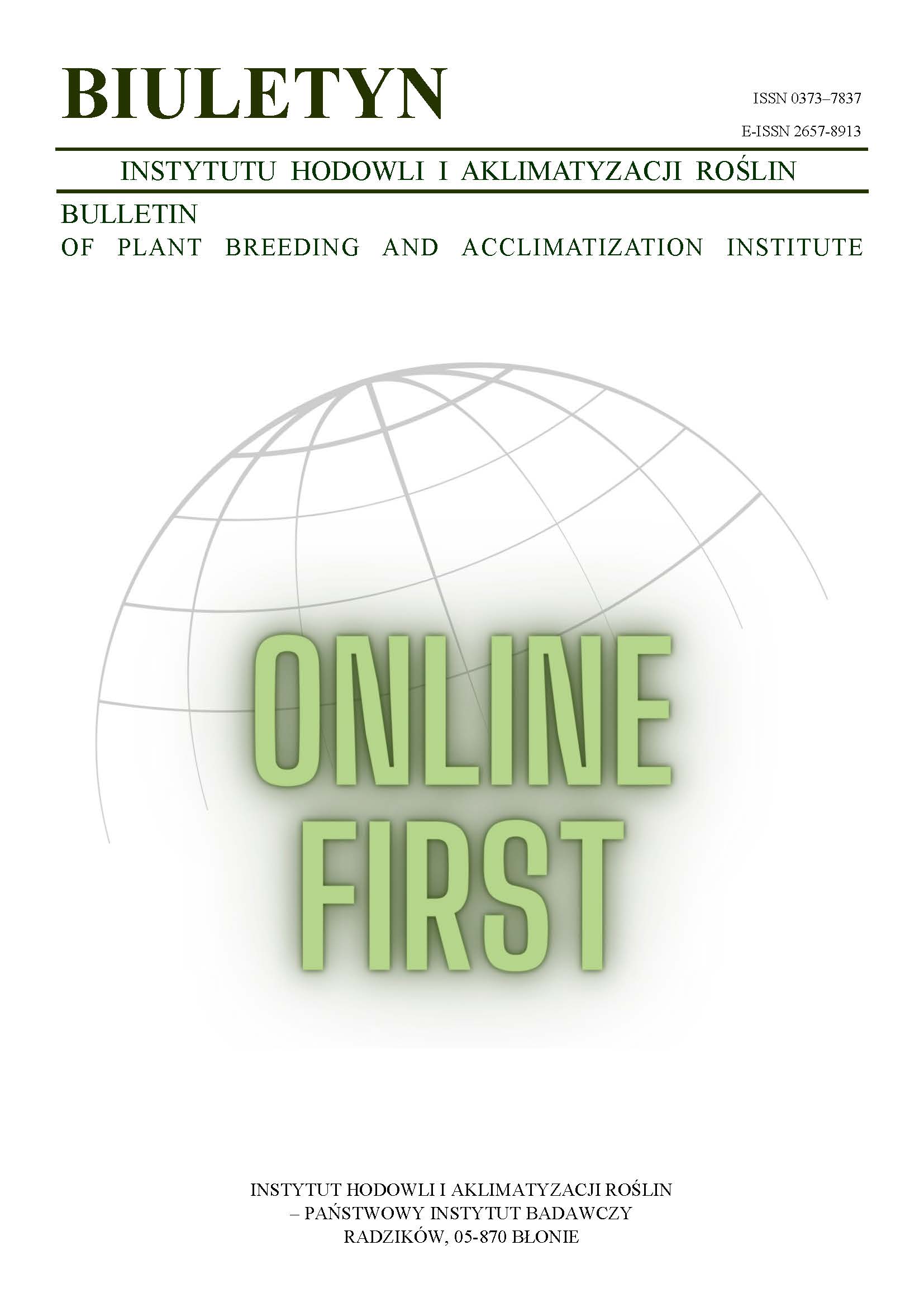The role of green manures, in form of undersown cover crops, and straw in sugar beet cultivation
Part I. Sugar beet plantations infestation with weeds
Danuta Buraczyńska
iro@uph.edu.plKatedra Szczegółowej Uprawy Roślin, Akademia Podlaska w Siedlcach (Poland)
Feliks Ceglarek
Katedra Szczegółowej Uprawy Roślin, Akademia Podlaska w Siedlcach (Poland)
Abstract
The research aimed at evaluation of the effect of biomass of undersown cover crop (the control treatment without organic mass, farmyard manure, undersown cover crop: black medic, Westerwold ryegrass, black medic + Westerwold ryegrass) and barley straw (the treatment without straw and the treatment with straw application) on weed infestation of sugar beet field. The field experiment was carried out in the split-block design with three replications, at the Experimental Farm in Zawady, on a cereal-fodder strong soil, in the years 1997–2000. Species composition, number of weeds and their air dry weight were studied after sugar beet germination and at the harvest date. Sugar beet weed infestation was significantly lower in the combinations including organic fertilization, when compared with the control treatment. The effect of biomass of the mixture of black medic and Westerwold ryegrass, which limited the weed infestation of sugar beet after its germination, was similar to the effect of farmyard manure and even more favourable at the harvest time. After sugar beet germination, the dominating weed species were: Agropyron repens, Chenopodium album, Echinochloa crus-galli, Galium aparine, Viola arvensis. At the sugar beet harvest date, Agropyron repens, Amaranthus retroflexus, Chenopodium album, Solanum nigrum, Stellaria media, were found on most of the experimental plots.
Keywords:
farmyard manure, sugar beet, straw, undersown cover crop, weedsReferences
Banaszak H., Gutmański I., Kostka-Gościniak D., Nowakowski M., Szymczak-Nowak J. 1998 a. Wpływ udziału buraka cukrowego w płodozmianie, stosowania słomy i międzyplonu na plonowanie i zdrowotność roślin. Acta Acad. Agricult. Tech. Olst., Agricultura 66: 239 — 246.
Google Scholar
Banaszak H., Nowakowski M., Szymczak-Nowak J., Ojczyk K. 1998 b. Limiting of Heterodera schachtii Schm., diseases and weeds of sugar beet by tillage system based on mustard or radish intercrops and mulches. Jurnal of Plant Protection Research 38 (1): 70 — 80.
Google Scholar
Bockmann H., Knoth K. E. 1971. Der verstärkte Getreidebau aus pflanzenpathologischer und pflanzenhygienischer Sicht. Z. Pfl-Krankheit. 1 (78): 1 — 33.
Google Scholar
Buraczyńska D. 2004. Znaczenie nawozów zielonych z międzyplonów wsiewek i słomy w uprawie buraka cukrowego. Cz. II. Plon i cechy biometryczne korzeni buraka cukrowego. Biul. IHAR 234: 181 — 190.
Google Scholar
Dziadowiec H. 1987. Przemiany w glebie słomy zbóż stosowanej jako nawóz organiczny i jej agroekologiczne działanie. Post. Nauk Rol. 4: 39 — 58.
Google Scholar
Garbe V., Heitefuβ R. 1986. Mulchsaat von Zuckerrűben. Zuckerrűbe 35 (3): 170 — 173.
Google Scholar
Gonet Z., Gonet Z. 1981. Reakcja niektórych roślin na uprawę w okresowej monokulturze w różnych warunkach siedliskowych. Cz. I. Burak cukrowy. Pam. Puł. 74: 47 — 57.
Google Scholar
Gutmański I., Kostka-Gościniak D., Szymczak-Nowak J., Nowakowski M., Kłos W., Sitarski A. 1999. Stan zachwaszczenia plantacji buraka cukrowego uprawianego z siewu w mulcz. Fol. Univ. Agric. Stetin 195, Agricultura 74: 105 — 114.
Google Scholar
Gutmański I., Pikulik R. 1992. Przydatność facelii i roślin krzyżowych jako poplonu ścierniskowego w uprawie buraka cukrowego. Mat. Konf. Nauk. „Nawozy organiczne”, AR Szczecin, 1: 229 — 236.
Google Scholar
Kolbe G., Stumpe H. 1975. Nawożenie słomą. PWRiL Warszawa.
Google Scholar
Kordas L. 2000. Studia nad optymalizacją uprawy buraka cukrowego na glebie średniej. Zesz. Nauk. AR Wrocław 386, Rozprawy CLXXI.
Google Scholar
Kordas L., Perylak D. 1998. Wpływ następczy zróżnicowanej agrotechniki buraka cukrowego na zachwaszczenie pszenicy ozimej uprawianej techniką siewu bezpośredniego. Progress in Plant Protection 38 (2): 684 — 687.
Google Scholar
Krężel R. 1991. Wpływ sposobów i terminów przyorywania obornika na plonowanie buraków cukrowych. Biul. IHAR 178: 41 — 45.
Google Scholar
Kubiak R. 1995. Wpływ przyoranej masy organicznej pozostającej na polu po zbiorze kukurydzy uprawianej na ziarno i na kiszonkę na właściwości gleby i plonowanie roślin następczych. Cz. II. Właściwości chemiczne, fizyczne i biologiczne gleby. Rocz. AR Poznań CCLXIX, Rol. 45: 65 — 73.
Google Scholar
Łęgowiak Z., Wysmułek A. 1997. Zachwaszczenie wtórne roślin ze szczególnym uwzględnieniem buraka cukrowego. Mat. z XXI Krajowej Konf. Nauk. „Rejonizacja chwastów segetalnych w Polsce. Zachwaszczenie wtórne roślin okopowych i ściernisk”. IUNG Puławy: 53 — 59.
Google Scholar
Niewiadomski W. 1980. Główne problemy teoretyczne specjalistycznych zmianowań. Zesz. Nauk. ART Olsztyn 3: 9 — 19.
Google Scholar
Pałys E., Podstawka-Chmielewska E., Kwiatkowska J. 1999. Zachwaszczenie łanu roślin w trójpolowym zmianowaniu na rędzinie w zależności od sposobu uprawy roli. Annales UMCS, Sec. E, Vol. LIV, 1: 1 — 12.
Google Scholar
Pawłowski F. 1991: Niektóre czynniki zachwaszczenia buraka cukrowego. Biul. IHAR 178: 55 — 58.
Google Scholar
Pawłowski F., Deryło S. 1991. Wpływ poplonów ścierniskowych na plonowanie buraka cukrowego w zmianowaniach o różnym udziale zbóż. Biul. IHAR 178: 113 — 120.
Google Scholar
Reszel R. S., Klikocka H., Komisarczuk K. 1994. Wpływ użyźniania gleby ziemią z osadów cukrowni na wtórne zachwaszczenie buraka cukrowego. Fragm. Agron. 2 (42): 66 — 71.
Google Scholar
Rola J. 1994. Systemy chemicznego odchwaszczania plantacji buraków cukrowych. Instrukcja upowszechnieniowa 43/94. IUNG Puławy.
Google Scholar
Szymczak-Nowak J., Kostka-Gościniak D., Nowakowski M., Gutmański I. 2002. Systemy uprawy buraka cukrowego na różnych glebach. Cz. V. Stan zachwaszczenia plantacji. Biul. IHAR 222: 341 — 348.
Google Scholar
Wesołowski M. 1994. Wpływ sposobu regeneracji stanowiska na zachwaszczenie pszenicy ozimej i jęczmienia jarego uprawianych w monokulturze. Annales UMCS, Sec. E, Vol. XLIX, 1: 5 — 9.
Google Scholar
Wesołowski M., Bętkowski M. 2000. Wpływ sposobu regeneracji stanowiska na plonowanie i zachwaszczenie buraka cukrowego. Zesz. Probl. Post. Nauk Rol. 470: 173 — 180.
Google Scholar
Wójcik-Wojtkowiak D. 1987. Rola allelopatii w rolniczych ekosystemach. Post. Nauk Rol. 1/2: 37 — 55.
Google Scholar
Zawiślak K., Adamiak E. 1987. Zbiorowiska chwastów buraka cukrowego uprawianego w płodozmianie i wieloletniej monokulturze. Acta Acad. Agricult. Tech. Olst., Agricultura 44: 179 — 190.
Google Scholar
Zimny L. 1994. Badania nad warunkami wzrostu i plonowania buraka cukrowego przy zastosowaniu zróżnicowanych technologii uprawy. Zesz. Nauk. AR Wrocław 241, Rozprawy CXXVI.
Google Scholar
Authors
Danuta Buraczyńskairo@uph.edu.pl
Katedra Szczegółowej Uprawy Roślin, Akademia Podlaska w Siedlcach Poland
Authors
Feliks CeglarekKatedra Szczegółowej Uprawy Roślin, Akademia Podlaska w Siedlcach Poland
Statistics
Abstract views: 59PDF downloads: 36
License
Copyright (c) 2004 Danuta Buraczyńska, Feliks Ceglarek

This work is licensed under a Creative Commons Attribution-ShareAlike 4.0 International License.
Upon submitting the article, the Authors grant the Publisher a non-exclusive and free license to use the article for an indefinite period of time throughout the world in the following fields of use:
- Production and reproduction of copies of the article using a specific technique, including printing and digital technology.
- Placing on the market, lending or renting the original or copies of the article.
- Public performance, exhibition, display, reproduction, broadcasting and re-broadcasting, as well as making the article publicly available in such a way that everyone can access it at a place and time of their choice.
- Including the article in a collective work.
- Uploading an article in electronic form to electronic platforms or otherwise introducing an article in electronic form to the Internet or other network.
- Dissemination of the article in electronic form on the Internet or other network, in collective work as well as independently.
- Making the article available in an electronic version in such a way that everyone can access it at a place and time of their choice, in particular via the Internet.
Authors by sending a request for publication:
- They consent to the publication of the article in the journal,
- They agree to give the publication a DOI (Digital Object Identifier),
- They undertake to comply with the publishing house's code of ethics in accordance with the guidelines of the Committee on Publication Ethics (COPE), (http://ihar.edu.pl/biblioteka_i_wydawnictwa.php),
- They consent to the articles being made available in electronic form under the CC BY-SA 4.0 license, in open access,
- They agree to send article metadata to commercial and non-commercial journal indexing databases.
Most read articles by the same author(s)
- Anna Płaza, Feliks Ceglarek, Milena A. Królikowska, Małgorzata Próchnicka, Table potato fertilization by biomass of intercrops in conditions of East-Central Poland , Bulletin of Plant Breeding and Acclimatization Institute: No. 254 (2009): Regular issue
- Anna Płaza, Feliks Ceglarek, Milena A. Królikowska, Małgorzata Próchnicka, The role of undersown crops in fertilization of table potato cultivar Syrena , Bulletin of Plant Breeding and Acclimatization Institute: No. 257/258 (2010): Regular issue
- Anna Płaza, Feliks Ceglarek, Barbara Gąsiorowska, Milena A. Królikowska, Małgorzata Próchnicka, Chemical composition of tubers of potato cultivar Fianna fertilized with intercrops and straw , Bulletin of Plant Breeding and Acclimatization Institute: No. 257/258 (2010): Regular issue
- Anna Płaza, Feliks Ceglarek, The response of potato variety Rywal to fertilization with undersown crops under conditions of central and eastern Poland , Bulletin of Plant Breeding and Acclimatization Institute: No. 232 (2004): Regular issue
- Danuta Buraczyńska, The role of green manures, in form of undersown cover crops, and straw in sugar beet cultivation. Part III. Content of macroelements in plants , Bulletin of Plant Breeding and Acclimatization Institute: No. 246 (2007): Regular issue
- Anna Płaza, Feliks Ceglarek, The influence of fertilization with undersown crops and straw on the yielding and chemical tuber composition of potato variety Ania , Bulletin of Plant Breeding and Acclimatization Institute: No. 232 (2004): Regular issue
- Danuta Buraczyńska, The role of green manures, in form of undersown cover crops, and straw in sugar beet cultivation , Bulletin of Plant Breeding and Acclimatization Institute: No. 234 (2004): Regular issue
- Danuta Buraczyńska, Fertilizing effect of farmyard manure and undersown cover crops on sugar beet , Bulletin of Plant Breeding and Acclimatization Institute: No. 228 (2003): Regular issue














